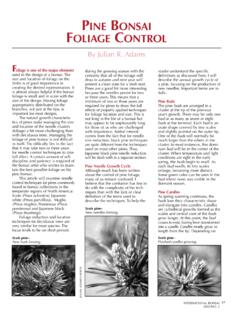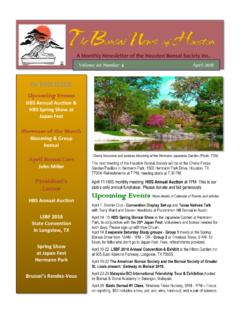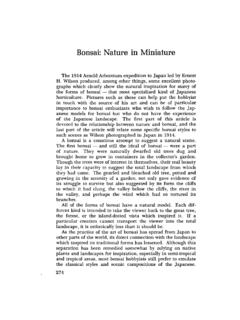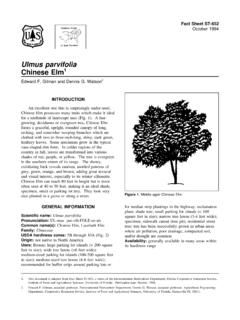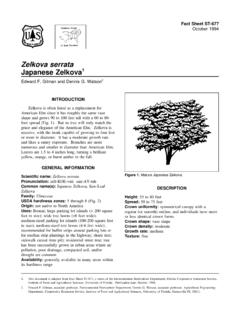Transcription of BONSAI BASICS - Central Florida Bonsai Club
1 BONSAI BASICS STUDENT HANDBOOK Objective Introduction History What makes good BONSAI Rules of BONSAI Sunlight Fertilizer Watering Insects & Disease Moss BASICS BONSAI Soil Trees 101 Growth Principles The Front Care of your tree (Before) Care of your tree (After) Wiring Basic Proportions Basic Design Pots Tools Glossary of terms 1 2 3 5 6 9 10 14 15 20 22 26 29 31 34 35 36 48 49 50 53 54 Table of Contents 1 This workbook was designed to aid the aspiring BONSAI artist by providing an overview of the many topics associated with BONSAI BASICS .
2 Most of the information included in this workbook was obtained from several online sources and has been reviewed to assure its accuracy. Along with the information from a qualified BONSAI artist, this handbook s material forms a detailed compilation of valuable facts and guidelines which will assist the aspiring artist in the growing and training of BONSAI . OBJECTIVE 2 BONSAI ( , "tray planting") is a Japanese art form using trees grown in containers. Similar practices exist in other cultures, including the Chinese tradition of penjing from which the art originated.
3 Japanese tradition dates back over a thousand years. " BONSAI " is a Japanese pronunciation of the earlier Chinese term penzai. The purposes of BONSAI are primarily contemplation (for the viewer) and the pleasant exercise of effort and ingenuity (for the grower), by contrast with other plant cultivation practices, BONSAI is not intended for production of food or for medicine. Instead, BONSAI practice focuses on long-term cultivation and shaping of one or more small trees growing in a container. A BONSAI is created beginning with a specimen of source material.
4 This may be a cutting, seedling, or small tree of a species suitable for BONSAI development. BONSAI can be created from nearly any perennial woody-stemmed tree or shrub species that produces true branches and can be cultivated to remain small through pot confinement with crown and root pruning. Some species are popular as BONSAI material because they have characteristics, such as small leaves or needles that make them appropriate for the compact visual scope of BONSAI . The source specimen is shaped to be relatively small and to meet the aesthetic standards of BONSAI .
5 When the candidate BONSAI nears its planned final size it is planted in a display pot, usually one designed for BONSAI display in one of a few accepted shapes and proportions. From that point forward, its growth is restricted by the pot environment. Throughout the year, the BONSAI is shaped to limit growth, redistribute foliar vigor to areas requiring further development, and meet the artist's detailed design. The practice of BONSAI is sometimes confused with dwarfing, but dwarfing generally refers to research, discovery, or creation of plant cultivars that are permanent, genetic miniatures of existing species.
6 BONSAI does not require genetically dwarfed trees, but rather depends on growing small trees from regular stock and seeds. BONSAI uses cultivation techniques like pruning, root reduction, potting, defoliation, and grafting to produce small trees that mimic the shape and style of mature, full-size trees. INTRODUCTION 3 While the art of BONSAI has long been associated with Japan, it actually originated first in China, and then spread eastward to Korea and then Japan. The art of BONSAI was spread by Buddhist monks who wished to bring the outdoors inside their temples.
7 From ancient paintings and manuscripts, we know that artistic container trees were being cultivated by the Chinese around 600 AD, but many scholars feel that BONSAI , or at least potted trees, were being grown in China as far back as 500 or 1,000 BC. BONSAI first appeared in Japan during the 12th century. It is no accident that artistic plant cultivation originated in China. The Chinese have always loved flowers and plants, and the country is naturally endowed with a rich diversity of flora. The Chinese also had a passion for gardens. In fact, many of these gardens were on a miniature scale and included many miniature trees and shrubs, planted to reinforce the scale and balance of their landscapes.
8 The Chinese, however, were also infatuated in miniaturization as a science in its own right. They believed that miniature objects had concentrated within them certain mystical and magical powers. The development of Chinese and Korean ceramics played an important role in the development of BONSAI as we know it today. Without the development of beautiful Chinese containers, BONSAI trees would not have been admired as much as they have been. BONSAI literally means tree in a tray. The tree and container must form a single entity. Even to this day the most desired containers for the finest Japanese BONSAI are often antique Chinese containers.
9 BONSAI has evolved and developed along different lines in China and Japan. Chinese BONSAI is still very much in the ancient tradition, and often appear crude to the uninformed. On the other hand, the Japanese styles are more pleasing and naturalistic. The Japanese trees are for the most part more refined and better groomed. Both types have their own individualistic charms and admirers. HISTORY 4 In the post-World War II era most of the BONSAI seen in the United States and Europe are Japanese in origin. The monopoly that Japan has enjoyed until recently is coming to be shared with a number of other countries, although the quality of Japanese trees continues to be of the highest quality.
10 Finally, we owe a great debt to the Japanese and Chinese artists for developing this beautiful art and for keeping it alive for almost 2,500 years. Without their enthusiasm, artistic tradition, and patient stewardship, we would not be enjoying BONSAI as we know it today. The aesthetic sensibilities of BONSAI , which have their roots in the Zen Buddhist tradition, contribute significantly to the complete BONSAI experience. 5 1. Signs of good health and stability such as leaf color and well settled, natural looking moss. No signs of carelessness and abuse such as badly healed pruning scars or scars from wire left on too long.
